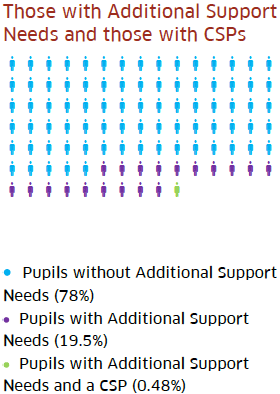Implementation of The Education (Additional Support for Learning) (Scotland) Act 2004: report to Parliament 2013
Progress report on the implementation of the Education (Additional Support for Learning) (Scotland) Act 2004 (as amended).
Background
What does the additional support for learning legislation do?
The Act places duties on education authorities and other agencies to provide additional support to children and young people who have an additional support need which is causing a barrier to their learning.
There are a wide range of factors that may lead to children and young people having a need for additional support. These fall broadly into four overlapping themes: learning environment, family circumstances, disability or health need and social and emotional factors.
Education authorities must broadly- identify, plan and make provision for the support to be provided and review that support to ensure it is appropriate. For some pupils, whose needs are complex or multiple and who need significant support from more than one agency, a co-ordinated support plan may be required. This is a statutory plan which co-ordinates and records the support to be provided. This plan has specific rights attached to it.
Who has additional support needs?
The Summary Statistics for Schools in Scotland, No.3, 2013 Edition indicates that in 2013 there were 673,530 pupils in Scotland's local authority primary, secondary and special schools and grant-aided schools. Of those, 131,621 were identified as having an additional support need, around 19.5% of all pupils. This is a 1.5% percentage point increase on last year.
Of those pupils identified as having an additional support need 40,089 (30%) have an Individualised Educational Programme ( IEP) a percentage point decrease of 6 on last year. 12,102 (9.1%) have a child's plan, provided through the Getting It Right for Every Child approach, a percentage point increase of 67% on last year. 3,279 (2.4%) were identified as having a co-ordinated support plan ( CSP).a percentage point decrease of 0.5 on last year Those pupils with CSPs represent 0.48% of all pupils in local authority and grant-aided schools.
This is represented by the diagram below which represents the whole pupil population, those with additional support needs and those with a co-ordinated support plan. For accuracy those with CSPs would be just under 0.5 of a person.
More boys (62%) than girls (38%) are identified as having additional support needs. These figures do not include those attending independent schools either under private arrangements or as a result of being placed by an education authority.
In 2013, there were 795 pupils in independent special schools in Scotland. The places of 771 of these pupils (96.98%) were funded by Scottish Local Authorities.
How are Additional Support Needs identified?
Education authorities and schools identify most children and young people with additional support needs through their arrangements for assessing learning and for monitoring the educational progress of children and young people. Assessment identifies the actions required to maximise development and learning and is a dynamic process with the child or young person at the centre.
Identification will usually include discussion with parents and professionals involved with the child or young person, for example, class teacher, support for learning staff, speech and language therapist, social worker, foster carer or residential worker. It should build on other assessment information already available. It may involve observation in one or more day-to-day situations and/or individual work with the child or young person as required.

Planning for Additional Support Needs
As indicated above, there are a range of planning mechanisms available to support children's and young people's additional support needs. These are extracted from national statistics and set out in the diagram below.
Transitional Arrangements
The inaugural report to Parliament on implementation of additional support for learning indicated that in most schools in Scotland the needs of most children and young people were being met well, with some major strengths. Whilst this is very positive the report also acknowledged that additional support for some groups of children and young people could be improved upon.
Evidence provided in the inaugural report suggested that there remained scope for improvement on transition planning for young people with additional support needs. This report provides comment and case studies gathered by Education Scotland of a range of practice across provisions on this area.
Contact
There is a problem
Thanks for your feedback